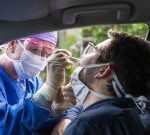
As the daily U.S. coronavirus death toll averaged more than 1,000 for the ninth straight day on Tuesday, governors from seven states banded together to shorten turnaround time for COVID-19 test results. Three Republican governors and three Democratic governors signed an interstate testing agreement on Tuesday, The New York Times reported. Louisiana, Maryland, Massachusetts, Michigan, Ohio and Virginia will work with the Rockefeller Foundation and two U.S. manufacturers of rapid tests to buy 3 million tests, the newspaper said. A seventh state, North Carolina, later joined the pact, CNN reported. The bipartisan plan illustrates just how bad testing delays are across the country. The United States is testing about 755,000 people a day, up from about 640,000 per day a month ago, the Times reported. But with testing chemicals and other equipment in short supply, and a surge in coronavirus cases nationwide, many Americans are still having to wait many days for results, the Post reported. Most people who are tested do not receive results within the 24 to 48 hours recommended by public health experts to slow the virus’s spread and quickly conduct contact tracing, according to a new survey by researchers from Harvard University, Northeastern University, Northwestern University and Rutgers University, the Times reported. People who had been tested for the virus in July reported an average wait time of about four days,… read on >

















